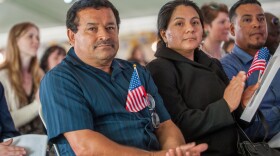Governor Greg Abbott's recommendations for increased school safety stems from the May 18 deadly shootings at Santa Fe High School near Houston. The tragedy and the debate over guns has had Dallas resident Aasim Saeed thinking back on his time at the school.
People are often surprised by the fond memories I have of growing up in Santa Fe, Texas. I guess in today’s political climate, it’s hard to think that a nerdy Muslim from Pakistan could get along so well in a conservative, largely white town. But I remind them, that when I first moved there in the early '90s, like most fifth-graders, I didn’t exactly know who I was yet – and so I was pretty adaptable to a new culture, a new identity.
In fact, I like to think I not just survived in Santa Fe, but thrived there because of the values we shared. For example, generations of Texans all view the gridiron as the land of opportunity for anyone willing to put in the work. Although I’d never played football before moving to Santa Fe, I quickly grew to love it because I could see my hard work and performance reflected on the field. By sophomore year, I made the varsity team and with that letterman jacket came the respect and support of not only my classmates, but the entire town. Despite my distinct religious, ethnic and cultural background, I wasn’t an outsider – I was part of a larger family.
As families often do, we didn’t always see eye to eye. Like many teenagers, I found my first political voice in high school, and more often than not, it didn’t match the pulse of the town. My junior year, shortly after the Columbine shooting, I took on the controversial topic of gun reform for a speech competition. Before I really knew what a Democrat or Republican stood for, I felt compelled to be a voice for sensible gun restrictions in a community that was looking for a very different solution. Although I doubt I convinced many, I always felt respected and heard and tried to ensure that I demonstrated that same courtesy to anyone I engaged.
The hot button issue never strayed far from my mind as I encountered the topic from multiple angles as a graduate student in medicine and public policy. However, it was a course on negotiations that reminded me how critical it is to not simply understand but also appreciate the values and identity of the other side.
Earlier this month, just a few days after the Santa Fe High School shooting, I attended a lecture by Daniel Shapiro, a professor of negotiations at Harvard Law. Over years of research, he’s participated in hundreds of international disputes where people are literally killing each other and studied how incredibly important the role of identity is conflict. He learned that when we hear ideas or arguments that conflict with our personal identity, we shut them out completely. I couldn’t help but think about the two sides of the gun debate in this country.
Growing up in Santa Fe, I knew immediately after the shooting that our community’s response would be a stark contrast from Parkland that occurred a month earlier – I knew that Santa Fe residents would not simply turn their back on firearms that are viewed as an essential part of their culture and identity. I also know that, despite our differing views on the best policy to prevent these terrible tragedies, they have the same desire to protect our children and safeguard our community as I do.
Reflecting on my life and friendships in Santa Fe, I feel strongly that moving this national conversation forward means starting with respect and appreciation for each others’ values and identities. Then, I hope, we can find solutions that don’t create winners and losers.
Aasim Saeed is a 2001 graduate of Santa Fe High School. He’s now Director of Clinical Innovation at Baylor Scott & White Health.






